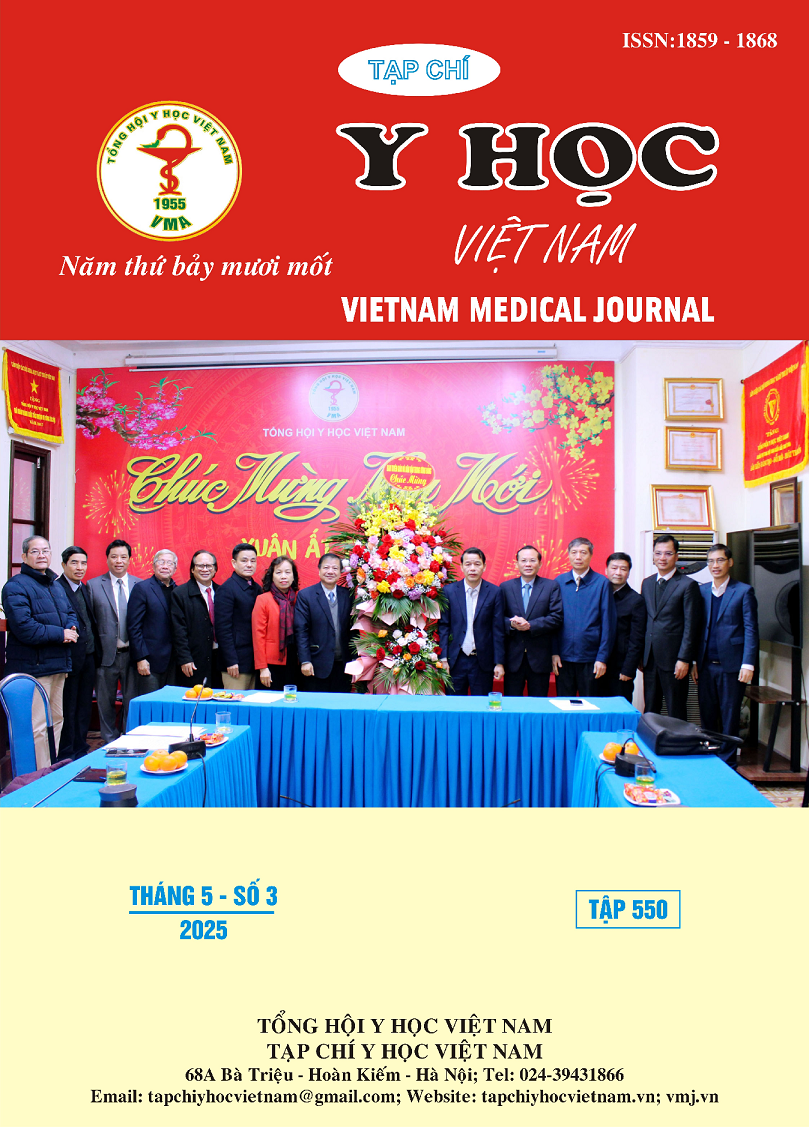OUTCOMES OF PATIENTS WITH INTRACRANIAL HEMORRHAGE USING ORAL ANTICOAGULANTS AT THE STROKE CENTER OF BACH MAI HOSPITAL
Main Article Content
Abstract
Objective: Outcomes of intracerebral hemorrhage patients currently using oral anticoagulants. Compare patient characteristics between two groups of patients using DOACs and VKAs at the Stroke Center of Bach Mai Hospital. Subjects and Methods: Descriptive study of patients diagnosed with intracerebral hemorrhage and with a history of oral anticoagulant use at the Stroke Center of Bach Mai Hospital from October 2023 to October 2024. Outcomes and characteristics of intracerebral hemorrhage patients were described in both DOAC and VKA groups. Results: The study included 36 patients, of which 32 cases (88.9%) were using VKAs and 4 cases (11.1%) were using DOACs (including 3 Rivaroxaban, 1 Endoxaban). The ages was commonly found in elderly patients ≥65 years old, being treated for atrial fibrillation, with a mortality rate over 50%. There was no difference in clinical symptoms between the DOAC and VKA groups; however, INR and APTT indices in the VKA group were significantly higher than in the DOAC group (p<0.05). The most common bleeding location on CT-scan and MRI was above the cerebellum tentorium in both groups. Conclusion: Intracerebral hemorrhage in the VKA group was more common than in the DOAC group. Close monitoring of INR is necessary in patients using VKAs, especially in elderly subjects. Beyond mandatory indications, using DOACs as an alternative to VKAs should be considered when indicated.
Article Details
Keywords
anticoagulation, DOAC, VKA, intracerebral hemorrhage
References
2. Phan Thị Điệp, Hoàng Bùi Hải. Đặc điểm lâm sàng, cận lâm sàng bệnh nhân đang dùng thuốc chống đông máu đường uống vào cấp cứu với bất kì chảy máu nào. VMJ. 2024;535(1). doi:10.51298/vmj.v535i1.8567
3. Lyman GH, Bohlke K, Khorana AA, et al. Venous thromboembolism prophylaxis and treatment in patients with cancer: american society of clinical oncology clinical practice guideline update 2014. J Clin Oncol. 2015;33(6): 654-656. doi:10.1200/JCO.2014.59.7351
4. Mai Như Chất. Đánh giá tình trạng sử dụng một số thuốc chống đông và đông máu trên bệnh nhân cao tuổi được phẫu thuật tại bệnh viện hữu nghị việt đức. luận văn chuyên khoa cấp II. Đại học Y Hà Nội; 2020. Accessed April 23, 2024. http://dulieuso. hmu.edu.vn/handle/hmu/2632
5. Mai Xuân Thiên. Nghiên cứu áp dụng thang điểm ich và ich-gs trong tiên lượng bệnh nhân xuất huyết não nguyên phát tại khoa cấp cứu. luận văn thạc sỹ y học. Đại học Y Hà Nội; 2018.
6. Xian Y, Zhang S, Inohara T, et al. Clinical Characteristics and Outcomes Associated With Oral Anticoagulant Use Among Patients Hospitalized With Intracerebral Hemorrhage. JAMA Network Open. 2021;4(2):e2037438. doi:10.1001/jamanetworkopen.2020.37438
7. Morotti A, Goldstein JN. Anticoagulant-associated intracerebral hemorrhage. Brain Hemorrhages. 2020;1(1):89-94. doi:10.1016/ j.hest.2020.01.001
8. Lauer A, Pfeilschifter W, Schaffer CB, Lo EH, Foerch C. Intracerebral haemorrhage associated with antithrombotic treatment: translational insights from experimental studies. Lancet Neurol. 2013;12(4): 394-405. doi:10.1016/S1474-4422(13)70049-8
9. Safatli DA, Günther A, Schlattmann P, Schwarz F, Kalff R, Ewald C. Predictors of 30-day mortality in patients with spontaneous primary intracerebral hemorrhage. Surg Neurol Int. 2016;7 (Suppl 18):S510-517. doi:10.4103/ 2152-7806.187493
10. Wilson D, Seiffge DJ, Traenka C, et al. Outcome of intracerebral hemorrhage associated with different oral anticoagulants. Neurology. 2017;88(18): 1693-1700. doi:10.1212/WNL. 0000000000003886


